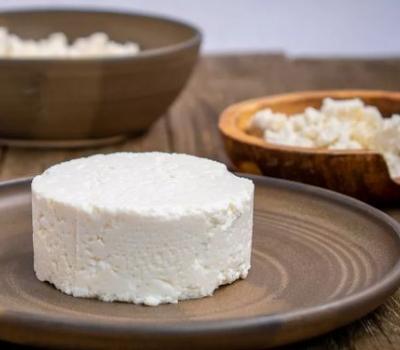All tags
5 star recipes
A
air fry
alcohol beverages
Beverages
BREADS
Breakfast
cakes
Candy
Casseroles
charcuterie boards
Chicken
chili
Chinese
Chowder
Christmas
coffee cakes
Conversion Chart
cookies
dale.
DESSERTS
DIPS
easter
fish
Freezer Meals
Friends
Halloween
herbs/spices
jan's canning
jan's ice cream
meat
Mexican
MISC
Muffins
new years
pasta
Pastry
Pies
polish
Potatoes
potpourri
pressure canner
QUICK BREADS
Rice
Salad Dressings
SALADS
sandwich spreads
Sandwiches
Seafood
Skillet
SNACKS
Soup
st. patrick
Stews
summer
t
Thanksgiving
Vegetables

Homemade Queso Fresco Cheese
Queso fresco cheese is creamy and fresh and typically made from cow or goat's milk. Make it at home with this simple recipe.
One advantage of making this cheese yourself is that you can control its texture. Queso fresco curds can be "pressed" into a firmer cheese that can be sliced, crumbled, and even fried (this cheese does not "melt" but will get softer when heated). Or you can simply strain it with cheesecloth and enjoy a creamier, more spreadable texture. Queso fresco is enjoyed on everything from arepas to potatoes to plantains and is even used in sauces and baked goods.
Ingredients
1/2 gallon whole milk
1/2 cup whipping cream
1 cup buttermilk
1 tablespoon salt
4 to 5 tablespoons vinegar (apple cider or distilled white vinegar)
Instructions
Gather the ingredients.
In a large pot, combine the milk, whipping cream, buttermilk, and salt. Stir over medium heat until the temperature reaches 190 F (or nearly a boil). Remove from heat.
Stir in the vinegar, one tablespoon at a time. Small curds will begin to form. Stir gently for 5 minutes or so, then let the mixture cool for 10 more minutes.
Line a large colander with 2 to 3 layers of cheesecloth. Slowly pour the milk mixture into the colander, letting the whey (the clear liquid) drain away into a bowl.
When most of the whey has drained off and the cheese is cool enough to handle, lift the edges of the cheesecloth up and twist, wrapping the cheese securely inside the cheesecloth. Squeeze off excess whey.
Hang the cheesecloth "bag" over the sink (use a clip to hang it from the faucet, for example) and let the whey drain for about an hour.
Once the cheese is well-drained, store the cheese in the refrigerator in an airtight container. Alternatively, you can press the curds by following the instructions below.
How to Press Curds for Firmer, Molded Cheese
Once the cheese curds are well drained, place a ring mold (or clean, empty metal can with both lids removed) on a baking sheet or flat dish. Spoon curds inside of the ring.
Cover the curds with a piece of wax paper, then use another can or something heavy to press down on them. Place the cheese in the refrigerator and press for 3 to 4 hours, or overnight.
Remove from the mold and wrap cheese with plastic wrap or place in an airtight container.
Tip
You can save the whey and use it in baked goods, in place of buttermilk or yogurt.
When molding the cheese, use a heavy object that will just fit inside the ring or can. One solution is to cut a circle of heavy cardboard that is just smaller than the ring's circumference. Place the cardboard circle on top of the wax paper to evenly distribute the weight, then use an object like a smaller can to provide the weight on top.
Store cheese for up to 1 week in the refrigerator.
What Can Queso Fresco Be Used For?
Queso fresco has many uses, and its crumbly texture is often enjoyed as a topping. Use it as you would feta or goat cheese (it works as a substitute for both in many cases). Crumble it on enchiladas, tacos, summer salads, and egg dishes, such as huevos rancheros. It's a great contrast to spicy dishes, but also works with fresh fruits and herbs, including a refreshing watermelon-mint salad. In recipes, such as chile rellenos, queso fresco becomes part of the filling.